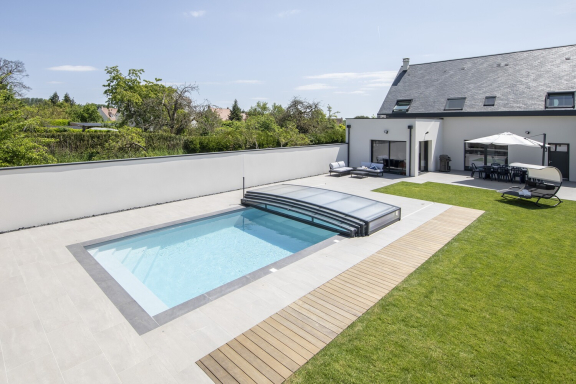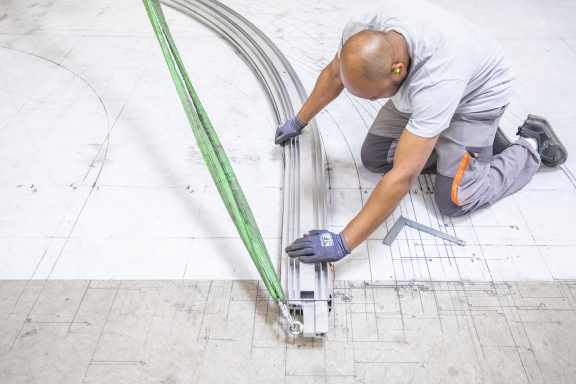The success of carports: 7 benefits of installing of a carport
Carports are enjoying real success, and for good reason: this type of very simple installation offers numerous advantages. So, why build a carport on your property? What should you know before starting out on this type of construction project? Discover the 7 benefits of carports and all the essential information you need to install one.
What is a carport?
A carport is a shelter for a vehicle. It consists of a roof supported by uprights. It can be used to park your car or even a motorhome in order to protect the vehicle from bad weather without a garage.
A carport can be adjacent to your home or be installed elsewhere on your property. The many models available and the possibilities of materials enable you to build a structure that is adapted to your environment and one that matches the aesthetics of the existing building.
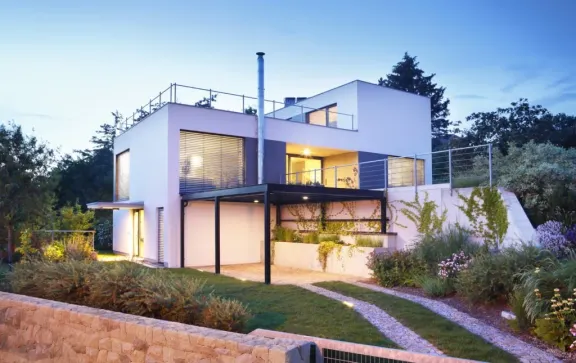
The 7 advantages of a carport
Perhaps you are wondering whether a carport is the best solution for you? To help you make your choice, here are the 7 advantages of this type of construction.
It protects your vehicle
The primary role of a carport is to protect your cars. A carport will enable you to keep them under shelter from harsh weather. Heavy rain, hail, sunshine: you car will be protected when you are not using it. Because it is less subject to the vagaries of the climate, it will also stay cleaner and suffer less damage, enabling you to save time on day-to-day maintenance. Nor will you have to remove the snow from your car before being able to drive in winter.
A carport is quickly installed
A carport consists of few elements (a roof and posts), which means that it can be easily installed on your property. Of course, you will have to build a solid foundation to ensure that the installation is stable and durable. But in any case, it is a relatively simple job.
Carports are versatile
With a bespoke carport, you will benefit from an installation that is perfectly adapted to your needs. A carport can also be used to park a motorhome, two cars, motorcycles or bicycles. You can choose the materials and colour to suit your personal taste, as well as the surface area to protect and the height of the roof.
Carports are economical
A carport is the most economical solution to create a sheltered parking space at your home. Its simplicity means that it is an economical construction. The price of a carport mainly depends on the structural material you choose. Indeed, certain materials are more expensive, but also more durable, than others.
Carports are easy to use
A carport is an open place: no particular effort is required to park your car, apart from passing between the posts. This ease of parking enables you to leave quickly and park your car just as easily. If you use your car daily, it is a real advantage that will make life easier for you. Add an automatic gate to your property and you will be able to come and go without a care.
Carports are durable
Designed to resist harsh weather, a carport is robust. It will withstand any hailstorms that could damage your car and benefits from optimal weather resistance. Depending on the material you choose and the type of foundation, you carport can be particularly resistant. An aluminium structure, in particular, will protect your vehicle for years to come.
Carports require little maintenance
The maintenance of a carport depends on the structural material chosen. Here, too, aluminium is the best option because it can be cleaned with a simple hose, if necessary. Wood and metal both require a little more attention, but remain solutions that require little day-to-day effort.
Is a carport a better choice than a garage?
Both a carport and a garage share the same basic purpose: to shelter your cars. Each of these constructions has its advantages and disadvantages. A garage can enable you to store other elements (equipment used occasionally, tools, etc.) and can be locked. So, why choose a carport rather than a garage?
- A garage is an extension to the house. Its installation is therefore more complex than a carport. You will have to apply for a building permit and undertake more long and complex works.
- A carport is less expensive than a garage.
- A carport facilitates parking, with no need to open and close a garage door.
- Air circulates better in a carport, which is entirely open. This prevents condensation from forming and the appearance of rust.
- A carport is located within the limits of your property and is therefore no less secure than a garage if your plot is fenced.
The different types of carport
Free-standing or lean-to, a carport can be independent or adjacent to the house.
The lean-to carport
A lean-to carport is supported by its posts and a wall of the house. As it is built in the continuity of your house, it will complete it. Being supported by a wall, it offers the possibility of building a sloping roof that will reduce the accumulation of snow and leaves. Lastly, as it adjoins your house, it also enables you to load and unload your vehicle while remaining under shelter.
The free-standing carport
A free-standing carport is only supported by its posts. It can be installed next to the house, but can also be installed elsewhere. This type of structure may be the solution if you have a large plot of land or to park vehicles that you only use occasionally, like a motorhome.
A carport for a motorhome
If you decide to install a carport to shelter a motorhome, the materials will be the same as for a car. However, the dimensions of the construction must adapt to the larger size of this type of vehicle.
Thus, when you launch your project, it will be important to clearly determine the use you wish to make of the carport to ensure that the structure you choose corresponds exactly to your needs.
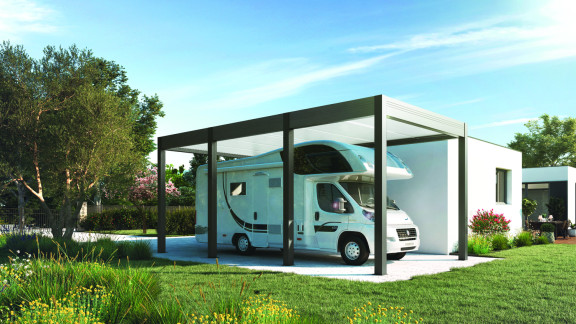
What are the dimensions of a carport?
A carport is made to measure, so the dimensions will vary from one carport to another. The size of the shelter will be determined by the vehicles that it will protect. Generally speaking, in order to park a car, a carport occupies a space of 12 to 15 m², with a height of 2 to 3 m.
Of course, the carport may be much higher if it is designed for a motorhome, or will occupy a greater surface area if you have several cars. To determine the height, start from the height of the vehicle and add at least 50 cm for sufficient headroom.
The materials used for the construction of a carport
The choice of the material used to manufacture a carport will strongly influence the price of the installation. Some will be more resistant and require less maintenance than others. What materials can be used?
The structure
You will first have to choose the material for the structure:
- Wood is very often used for its natural charm and solidity. It will be important to choose quality wood that can resist humidity and which has been treated against fungi and insects.
- Steel is highly resistant and can bear heavy loads. Its disadvantage: it is necessary to apply an anti-rust treatment every year to maintain the structure in good condition.
- PVC is the most economical solution, but it is less resistant and much less durable over time.
- Aluminium is light and durable. It requires very little, or no, maintenance and has a very long service life. It is also very aesthetic and can be easily worked to adapt to specific needs.
The roof
The roof of a carport can also be made of various materials:
- Tiles can be used for a carport with a sloping roof. This enables the creation of an extension that is in perfect continuity with the house, but they must be laid on a very robust structure.
- Polycarbonate is highly resistant to harsh weather and has a very good service life.
- "Sandwich" panels consisting of two sheets of thermal aluminium linked to a central sheet of extruded polystyrene, a flat roof that yields good thermal insulation and a resolutely contemporary appearance
- Wood shingles are wooden tiles with a very attractive appearance.
- Bitumen shingles consist of a mixture of bitumen and fibres that imitate slate, but whose fragility is an inconvenience.
- Box profile steel panels are easily installed and will adapt to your taste with a wide range of models, sizes and colours.
Lastly, you will have the possibility, in certain cases, to add solar panels to the roof of your carport to obtain the maximum benefit.
The foundations: an earth floor or a concrete slab?
The foundations are very important for the installation of your carport and will determine its solidity. Indeed, the carport cannot be installed directly on bare ground and will at least need concrete deck blocks to support the posts.
Ideally, you should pour a concrete slab into which the posts will be inserted. This slab can then be covered by a lining to preserve the appearance of the surroundings. You can then choose to install gravel, paving stones, tarmac or simply keep the concrete surface.
Which carport to choose?
Certain elements will play an important role when you choose the type of carport that is best suited to your situation: the context, the environment, the budget and, of course, your personal preferences.
The context
The reasons for which you wish to install a carport will already help you list the most important factors for your project. Your intended use will help you decide on the location of the carport. The type of vehicle that you will park under this shelter is also important because it will determine the dimensions of the structure.
The environment
The environment may then be decisive and help you to choose among different materials or models of roof. If you live in a region with significant snowfall, or if there are a lot of trees in the surroundings, a sloping roof will prevent the accumulation of snow or dead leaves. An insulating polycarbonate roof will also have the necessary strength to withstand heavy snowfall.
The budget
Your budget will, of course, also guide your decision. The price you will be able to invest in this shelter will enable you to install a carport that is more or less large, or to choose one material over another.
Aesthetics
Lastly, you shouldn't forget to take the aesthetics into account for your decision. You will probably see the carport every day. It will complete your house and must therefore adapt to it. Whether for the choice of location, material, roof or colour, your aesthetic preferences should play a role in the type of carport that you will install.
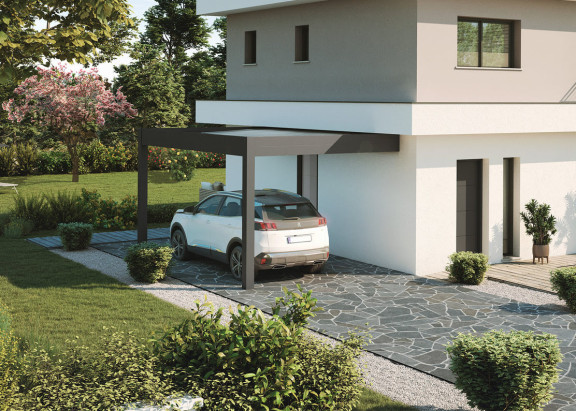
Where should you install your carport?
You can take the following factors into account in order to choose the most suitable location for your carport:
- Your intended use.For example, if you want to be able to easily unload your shopping, then a lean-to carport supported by a wall of your house will certainly be the most practical choice. On the other hand, if you need a carport to shelter your motorhome, it may be situated further away.
- The aesthetics. If your property is big enough, you may choose not to park your vehicles beside the house in order to preserve its charm.
- Parking manoeuvres. When choosing the location of your carport, try to imagine the manoeuvres that will be necessary to park there, especially if you intend to use this parking space on a daily basis. The carport should be easily accessible and without nearby obstacles.
- The terrain. It is important that the ground is flat and levelled for the proper installation of a carport.
- The neighbourhood. Depending on the town planning code of your municipality, it is quite possible that you will have to respect a certain distance between the location of the carport and the limits of your property.
The legislation concerning carports
A carport is more easily installed than a garage. However, this does not mean that there are no rules to respect. What regulations and taxes apply to carports?
What are the taxes for a carport?
From the legal point of view, a carport is a parking space that must be declared. It will thus be subject to a specific tax. This tax depends on your municipality and the number of parking places under the carport. It is paid when you file the works declaration or the building permit. Some municipalities nevertheless decide to waive taxes on annexes, so consult your town hall to find out what applies in your situation.
In addition to the carport tax, you must also take into account council tax and property tax. As a carport is an installation that adds value to a property, its construction generally influences the amount of these taxes.
Do you need a building permit to install a carport?
Everything depends on the carport you decide to install. Indeed, a carport that occupies a surface area of less than 5 m² requires no particular procedure. Between 5 m² and 20 m², a simple declaration of works is enough. On the other hand, if your carport is over 20 m², you will have to apply for a building permit before commencing construction work.
A two-vehicle carport is subject to a building permit in order to be added to your residence. In general, a surface area of 5 m² is not sufficient to park a vehicle, so you will probably have to at least file a declaration of works.
What regulations apply to carports?
Town planning regulations concerning carports may vary from one municipality to another. It is therefore very important to understand what is authorised and what is prohibited in your locality in order to plan a viable project.
The town planning code (PLU) may thus define the authorised surface area, the maximum height, the colour of the structure, the shape of the roof and the distance between the construction and neighbouring property. If you live in a protected area, specific regulations may also apply.
What is the procedure for the installation of a carport?
You have decided to install a carport on your property. What is the construction procedure?
Define the project
Before anything else, you must define what exactly you want to build. This is when you will have to take into account:
- Your intended use of the carport;
- Your aesthetic preferences;
- The possibilities with respect to your budget;
- What is authorised in your municipality.
A professional carport installer will provide you with good advice and enable you to define a bespoke project that is perfectly adapted to your constraints and wishes.
Undertake the administrative procedures
Once you have defined your project, you will have to perform the necessary administrative procedures to be able to launch construction work. Go to your town hall to apply for a building permit or to file a prior works declaration, depending on the type of carport you want to install. Settle the carport tax, which may, under certain conditions, be paid in several instalments.
Build the foundations
Once your building permit or woks declaration has been validated, you will be able to launch the installation of your carport. Construction starts with the foundations, in particular by pouring the concrete slab, if you have chosen this option, or the laying of concrete deck blocks.
Build the structure
Once the foundations have been laid, it will at last be possible to assemble the structure. Working with a professional, who will be able to take charge of the works from A to Z, is the best way to ensure the quality of your installation.
Can you install a carport yourself?
Installing a carport by yourself is possible if you are a confirmed DIY enthusiast and depends on the type of structure you wish to have. A wooden carport can be assembled by persons who have good DIY skills. However, working with a professional is worthwhile for many reasons:
- A professional will handle the installation from A to Z and advise you on the most suitable model for you.
- You will be assured of carefree installation and the proper stability of your carport.
- You may benefit from bespoke construction and more resistant materials.
If you decide to install your carport yourself and choose a rather basic model, beware: this choice makes no difference with respect to the administrative procedures and the same rules will apply as for a professional installation.
The shelter that a carport easily adds to your property is a real benefit. Choosing this type of installation will enable you to protect all your vehicles without resorting to the more complex construction of a closed garage. Ideally, you will be accompanied by a professional for your project. They will provide you with the best advice and enable you to build a bespoke structure that is perfectly suited to your specific needs.

